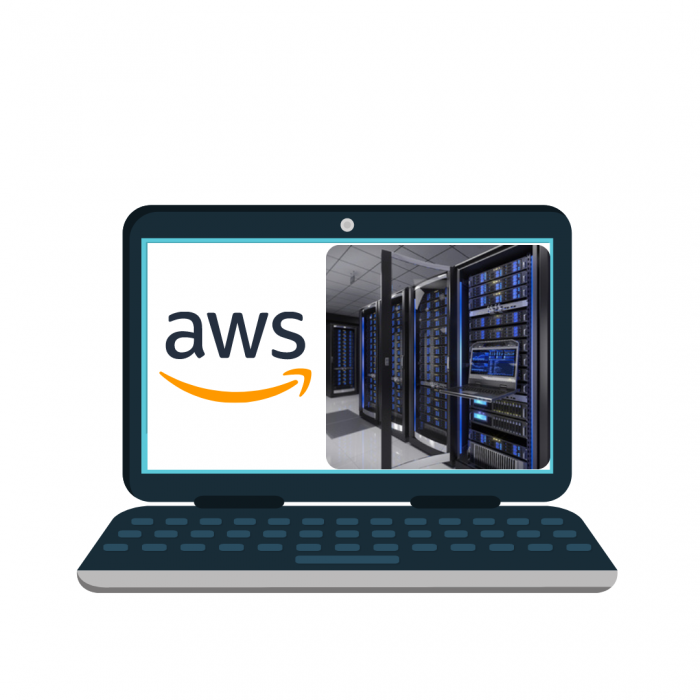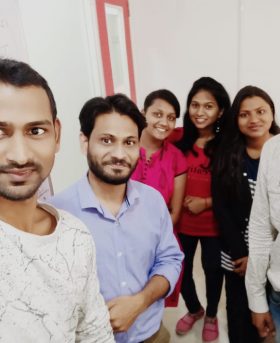AWS-Amazon Web Services
AMAZON WEB SERVICES (AWS)
Aws Training and Certification with 100% Job Guarantee – Oytie
What is Amazon Web Services (AWS)?
AWS is the secure cloud services platform which is subsidiary of Amazon. It offers many different services, tools and solutions for software developers which can be used in data centers. Amazon web services are used in many private and government organizations to manage the data, to store the data, for networking purpose, management, for security etc. We can use amazon web services on the basis of it’s advantages and features like, it have enhanced security, cost effectiveness, flexibility, elasticity and scalability. Learn the course and you will get to know how effective and futuristic technology is this. AWS training and certification is best ever combination to learn programming concepts all together and if you are learning it at oytie then this includes some extra benefits like,

Our AWS Training Course Specialities
Practical and industry oriented training with live projects
100% job assurance
Best course material
Real time case studies to practice
Mock interview sessions
Lifetime assistance for job
Who can do this course?
Freshers
BE/Bsc Candidates
Any Graduate
Any Post-Graduate
Syllabus of AWS Course in Pune
- Overview of all basic commands
- Vim editor modes
- Filesystem hierarchy – Basic topics
- File and directories creation
- Grep
- Filter commands (head,tail,more,less)
- Creating users and groups
- Important files related
- Modifying,deleting users and group
- Linux permissions
- Basic permissions overview
- Software management
- Yellowdog update modifier(yum)
- Yum commands
- Different runlevels
- Services and daemons
- Why Cloud and What is Cloud Computing?
- Identify the features and benefits of cloud computing
- Different types of Cloud Computing deployment model
- Public Cloud, Private Cloud, Hybrid Cloud
- Virtualization – An essential in cloud
- Virtualization in Cloud model
- Different types of virtualization
- Hypervisor – Benefits
- Different types of services and its difference in Cloud computing
- IaaS, PaaS, SaaS
- Importance of scaling in cloud computing
- Different types of scaling and its applications
- Issues we overcome using cloud and applications
- Cost model that we use in cloud computing
- Describe the features of AWS
- The features of AWS marketplace
- Describe the features of Amazon Compute Services
- Describe the features of Amazon Storage Services
- Describe the features of Amazon Network Services
- Describe the features of Amazon Database services
- Describe about various services in AWS
- Global Infrastruture – Regions and Availability Zones
- Create a free tier account in AWS and onboarding
- Introduction AWS management console
Module 4: Understand Identity Access Management of AWS
- Protect your AWS by different authentication system
- Password policies set for users
- AWS User Account and Groups in detail
- Creating custom policies in AWS
- Introduction about Roles and its use
- Creating Roles and associating policies
- Creating programmatic access and management console access for users
- Associating policies to the user and groups
- Describe AMI and AWS Marketplace templates
- Launch a basic EC2 instance
- Different types of Instances Reserved, On-demand, Spot, Dedicated
- Security groups and tags for EC2 instance
- Public key – Private key introduction and protecting EC2 with keys
- Attaching and detaching EBS volumes
- Launch an ec2 instance from an AMI
- Create custom AMI and working with different region
- Make use of amazon EBS volume and create snapshots
- Manage the configuration of your application
- Deploying a new instance from the created AMI
- Get Started with Auto Scaling Using the Console
- Creating Launch configurations and make use of it for autoscaling groups
- Maintain a Fixed Number of Running EC2 Instances
- Dynamic Scaling
- The lifecycle of autoscaling
- Policies of autoscaling
- Introduction to Loadbalancer (ELB)
- Different types of Loadbalancer in AWS
- Application Load balancer
- Network Load balancer
- Classic Load balancer
- Migrating classic load balancer to new load balancer
- Components and types of load balancing
Module 8: EBS (Elastic Block Storage)
- Create EBS volumes
- Delete EBS Volumes
- Attach and detach EBS volumes with EC2 instance
- Creating and deleting snapshots
Module 9: Object Storage in Cloud
- Understanding S3 durability and redundancy
- Introduction about S3 Buckets
- How S3 Uploading works and how to Download
- How to S3 Permissions
- How to implement S3 Object Versioning S3 Lifecycle Policies
- Storage Gateway
- Import Export
- S3 Transfer Acceleration
- Glacier storage
- Describing cloud front
- Creating a cloud front distribution
- Hosting a website of cloud front distribution
- Implementing global restrictions
- Configuring origins and behaviors
- Describe Hosted zones and Domain name understanding
- How to create hosted zones
- Hosting a website with custom domain name
- Understanding routing policies
Module 12: AWS Security Management
- Describing Security Practices for Cloud Deployment
- AWS Shared Responsibilities and Securities
- Importance of Cloud Trail
- Describing Trust advisor
Module 13: Amazon Virtual Private Cloud (VPC)
- Introduction to Amazon Virtual Private Cloud (VPC).
- VPC Advantages and understanding IP addressing CIDR
- Default and Non-default VPC
- Different Components in VPC
- Describe, create, and manage Amazon Virtual Private Cloud
- Amazon VPC, Private Subnet, and Public Subnet
- AWS Networking, Security Groups, and Network ACLs
- Configuration and management of VPN connectivity
- Subnet and Subnet Mask
Module 14: Relational Database Service (RDS)
- Introduction to RDS
- Different database services of AWS: Amazon RDS, Dynamo DB, Redshift etc.
- Create MYSQL RDS Instance, Oracle RDS Instance, MS SQL RDS Instance
- Configuring the database
- Configuring backups
- Configuring the maintenance windows
- Connecting to the database
- Creating a dynamo dB
- Adding data manually
- Learn about strong and eventual consistency
- Calculating Read write consistency
- Configuring alarms
Module 16: Monitoring Services
- Knowledge on Cloud watch – A monitoring service
- Create and Configuring Monitoring services
- How to perform Setting thresholds and Configuring actions
- Creating a cloud watch alarm
- Getting statistics for ec2 instances
- Monitoring other AWS services
- Configuring Notifications
- Integrating cloud watch with Auto scaling
Module 17: Application Services – An Overview
- What is SNS
- Creating a topic
- Create subscription
- Subscribed to the subscription
- SQS & SES
- Lambda and Elastic Beanstalk
Module 18: AWS Troubleshooting
- Troubleshooting EC2 instance
- Troubleshooting using Cloud watch
- Troubleshooting using ELB
- Troubleshooting by using Cloud front
Module 19: AWS Architecture and Design
- Backup and Disaster Recovery
- How to manage Disaster Recovery and Backups
- Best Practice for DR and Backups
- AWS High Availability Design
Module 20: DevOps Fundamentals
- An understanding of DevOps and the modern DevOps toolsets
- The ability to automate all aspects of a modern code delivery and deployment pipeline using:
- Source code management tools – CVS, Git
- Build tools – Apache ant, Maven
- Test automation tools – JUnit
- Continuous Integration Tools – Jenkins, Team city
- Configuration management tools – Chef, Puppet, Ansible
- Docker Ecosystem usage
- Understanding the ECS usage in Docker
- Docker package usage in a monolithic application inside docker container services
- AWS elastic container service(ECS) used to migrate monolithic application to AWS Cloud
- Purpose of Storage Gateway
- Snowball & Snowball edge services
- Direct Connect tool usage
- Introduction to DevOps
- DevOps Principles in detail
- DevOps Engineer Skills in the market
- Knowing DevOps Delivery Pipeline
- Market trend of DevOps
- DevOps Technical Challenges
- Tools we use in DevOps
- Knowing about Version control
- Git – A CLI
- Essentials of GIT in industry
- How to setup GIT
- Installing Git
- First-Time Git Setup
- Getting a Git Repository
- Working with various commands in GIT
- Recording Changes to the Repository
- How to check the Status of Your Files
- How to track New Files
- Staging our modified files
- Ignoring Files from GIT
- Viewing Your Unstaged and Staged Changes
- How to commit Your Changes
- Skipping the Staging Area and commit
- Removing Files from GIT
- Viewing the Commit History
- Limiting Log Output
- Using a GUI to Visualize History
- Undoing Things
- hanging Your Last Commit
- Unstaging a Staged File
- Unmodifying a Modified File
- Working with Remotes
- Showing Your Remotes
- Adding Remote Repositories
- Fetching and Pulling from Your Remotes
- Pushing to Your Remotes
- Inspecting a Remote
- Removing and Renaming Remotes
Download Broacher for AWS Course in Pune.
What after completion of AWS training in Pune?
As we can say now, you have completed the overall AWS training with certification and it’s time for interview calls. You have to be prepared with the knowledge and practical presentation if you have done any project in the training. So, as per the preparation we will give you an interview calls and you have to prove yourself in-front of the interviewer. We will assure you that we will give you 100% placement guarantee until you get placed.
Career Opportunities in AWS Course

Average Fresher’s Salary of AWS Course Certified Candidate in India
3-10 LPA
Batch Schedule
So, What’s the next step to start the course?
Enroll for our AWS Training and Certification course in pune and Make Your Future Bright!
Click Here and Reach to Us!
Some Happy Faces from Our Recent Batch




Some of our Recruitment partners








Previous
Next
Career Opportunities
Operational Support Engineer
Hyderabad, India
Cloud Software Engineer
Pune, India
Cloud Developer.
Mumbai, India
AWS Solutions Architect
Pune, India
AWS SysOps Administrator
Bangalore, India
